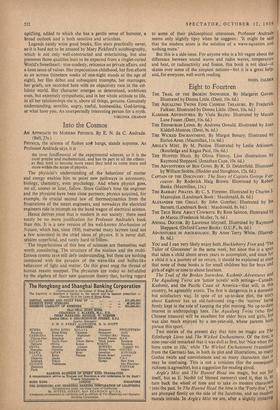Into the Cosmos
AN APPROACH TO MODERN PHYSICS. By E. N. da C. Andrade. (Bell, 25s.) AN APPROACH TO MODERN PHYSICS. By E. N. da C. Andrade. (Bell, 25s.)
the science of flashes and bangs, stands supreme. As Professor Andrade says, it is the most fund&mental of the experimental sciences, as it is the most-precise and mathematical, and has its part in all the others : as they tend to become more exact they tend to come more and more within the scope of physics.
The physicist's understanding of the behaviour of matter and energy enables him to point new pathways in astronomy, biology, chemistry, even psychology. And where physics goes, we all, sooner or later, follow. Since Galileo's time the engineer and the physicist have been close partners; physics acquired, for example, its crucial second law of thermodynamics from the frustrations of the steam engineers, and nowadays the electrical engineers ride in triumph on the band wagon of electrical science.
Hence derives most that is modern in our society : there need surely be no more justification for Professor Andrade's book than this. It is a new version of his well-known Mechanism of Nature, which has, since 1930, instructed many laymen (and not a few scientists) in the chief ideas of physics. It is never dull, seldom superficial, and rarely hard to follow.
The imperfections of this best of sciences are themselves well worth considering, The structure of the nucleus and the multi- farious cosmic rays still defy understanding, but these are nothing compared with the paradox of the wave-like and bullet-like behaviour of light and matter. On this great snag the thread of human reason snapped. The physicists are today so befuddled by the algebra of their new quantum theory that, having regard to some of their philosophical utterances, Professor Andrade seems only slightly tipsy when he suggests : 'It might be said that the modern atom is the solution of a wave-equation and nothing more.'
But this is a side-issue. For anyone who is a bit vague about the difference between sound waves and radio waves, temperature and heat, or radioactivity and fission, this book is not ideal—it skates over some of the simplest notions—but it is a great help, and, for everyone, well worth reading.
NIGEL CALDER










































 Previous page
Previous page